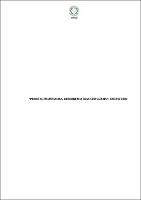| ???jsp.display-item.social.title??? |


|
Please use this identifier to cite or link to this item:
https://tede.ufam.edu.br/handle/tede/10443| ???metadata.dc.type???: | Dissertação |
| Title: | ‘Pronto, professora, demoremo, mas cheguemo’: um estudo sociolinguístico sobre a variação morfofonológica em verbos da 1ª e 2ª conjugações na fala de Tefé-Amazonas |
| ???metadata.dc.creator???: | Silva, Larissa Marine Terdulino da  |
| ???metadata.dc.contributor.advisor1???: | Bandeira, Grace dos Anjos Freire |
| ???metadata.dc.contributor.referee1???: | Azevedo, Orlando da Silva |
| ???metadata.dc.contributor.referee2???: | Silva, Raynice Geraldine Pereira da |
| ???metadata.dc.description.resumo???: | Esta é uma pesquisa de cunho variacionista e teve como objetivo mapear e descrever quantitativamente o uso do fenômeno linguístico da variação morfofonológica na P4, ocorrida em verbos regulares da 1ª e 2ª conjugação, nos tempos presente e pretérito perfeito, em formas canônicas, como chegamos e nascemos e suas variantes não canônicas cheguemo e nascimo. Trata-se de uma pesquisa sincrônica no âmbito da Teoria da Variação e da Mudança linguística (cf, LABOV, 2008 [1972], 1982, 1994; WEINREICH, LABOV, HERZOG, 2006 [1968]. A amostra é constituída por 12 entrevistas realizadas no período de 02 a 22 de maio na cidade de Tefé-Amazonas, de onde foi extraído o vernáculo dos informantes. Dos entrevistados, seis são homens e seis são mulheres, os quais são estratificados em três faixas etárias (de 9 a 21 anos; de 22 a 49 anos e acima de 50), com escolaridade Ensino Fundamental e Médio. Os fatores linguísticos trabalhados foram “tempo verbal”, “item lexical”, “apagamento ou não do -s no SNP” e “formas de preenchimento do sujeito”. A análise dos dados foi feita com base em percentuais e frequência, i.e, o conjunto de dados não foi submetido a um programa estatístico. Os resultados indicam que as formas não canônicas em [e-mo] e [i-mo] são realizadas com maior frequência na fala feminina, e entre os mais velhos e menos escolarizados. Da análise dos fatores linguísticos, as formas não canônicas fazem referência, na sua totalidade, ao contexto do pretérito perfeito do indicativo tanto em verbos da primeira quanto da segunda conjugação. Quanto aos itens lexicais, as variantes dos verbos chegar, ficar, passar, casar, começar e pescar, da primeira conjugação, foram as mais produtivas na fala dos informantes, e da segunda foram as variantes dos verbos nascer e viver. O apagamento do s, relativamente à desinência -mos, poderá estar atrelado ao uso das formas não canônicas, e o sujeito das narrativas é preenchido pelo pronome nós na maioria dos casos. |
| Abstract: | This research aims to map and quantitatively describe the use of the linguistic phenomenon of morphophonological variation in P4, which occurs in regular verbs of the 1st and 2nd conjugation, in the present and past perfect tenses, in canonical forms such as chegamos and nascemos and their non-canonical varieties cheguemo and nascimo. This is a synchronic study within the framework of the Theory of Linguistic Variation (see LABOV, 2008 [1972], 1982, 1994; WEINREICH, LABOV, HERZOG, 2006 [1968]. The sample consists of 12 typically Labovian interviews carried out between May 2nd and 22nd in the city of Tefé-Amazonas, from which the vernacular of the informants was extracted, i.e., we tried to ensure minimal speech monitoring during the one-to-one interviews. The interviews that make up our corpus include 6 men and 6 women, divided into three age groups (9 to 21 years old; 22 to 49 years old and 49 and over), with primary and secondary schooling. The linguistic factors worked on were "verb tense", "lexical item", "deletion or not of -s in the PNE", meaning personal number-ending, which is regarding to singular and plural forms, and "ways of filling in the subject". Data analysis was based on percentages and frequency, i.e., the data set was not submitted to a statistical program. The results indicate that the non-canonical forms (-emo) and (-imos) are frequently used by female informants, older informants, and those with less schooling. The analysis of linguistic factors shows that the non-canonical forms refer in their majority to the context of the past perfect in the indicative form both first and second conjugation verbs. The most common lexical items are the varieties of the verbs chegar, ficar, passar, casar, começar and pescar, from the first conjugation, while the second conjugation includes the varieties of the items nascer and viver. The deletion of -s in the SNP determines the use of non-canonical forms and the subject of narratives is most often filled with the pronoun nós. |
| Keywords: | Sociolinguística - Brasil, Norte Língua portuguesa - Português falado |
| ???metadata.dc.subject.cnpq???: | LINGUISTICA, LETRAS E ARTES: LINGUISTICA: SOCIOLINGUISTICA E DIALETOLOGIA |
| ???metadata.dc.subject.user???: | Sociolinguística Variação morfofonológica 1ª e 2ª conjugação Fala tefeense |
| Language: | por |
| ???metadata.dc.publisher.country???: | Brasil |
| Publisher: | Universidade Federal do Amazonas |
| ???metadata.dc.publisher.initials???: | UFAM |
| ???metadata.dc.publisher.department???: | Faculdade de Letras |
| ???metadata.dc.publisher.program???: | Programa de Pós-graduação em Letras |
| Citation: | SILVA, Larissa Marine Terdulino da. ‘Pronto, professora, demoremo, mas cheguemo’: um estudo sociolinguístico sobre a variação morfofonológica em verbos da 1ª e 2ª conjugações na fala de Tefé-Amazonas. 2023. 138 f. Dissertação (Mestrado em Letras) - Universidade Federal do Amazonas, Manaus, 2023. |
| ???metadata.dc.rights???: | Acesso Aberto |
| ???metadata.dc.rights.uri???: | https://creativecommons.org/licenses/by-nc-nd/4.0/ |
| URI: | https://tede.ufam.edu.br/handle/tede/10443 |
| Issue Date: | 15-Dec-2023 |
| Appears in Collections: | Mestrado em Letras |
Files in This Item:
| File | Description | Size | Format | |
|---|---|---|---|---|
| DISS_LarissaSilva_PPGL.pdf | 2.44 MB | Adobe PDF |  Download/Open Preview |
Items in DSpace are protected by copyright, with all rights reserved, unless otherwise indicated.




